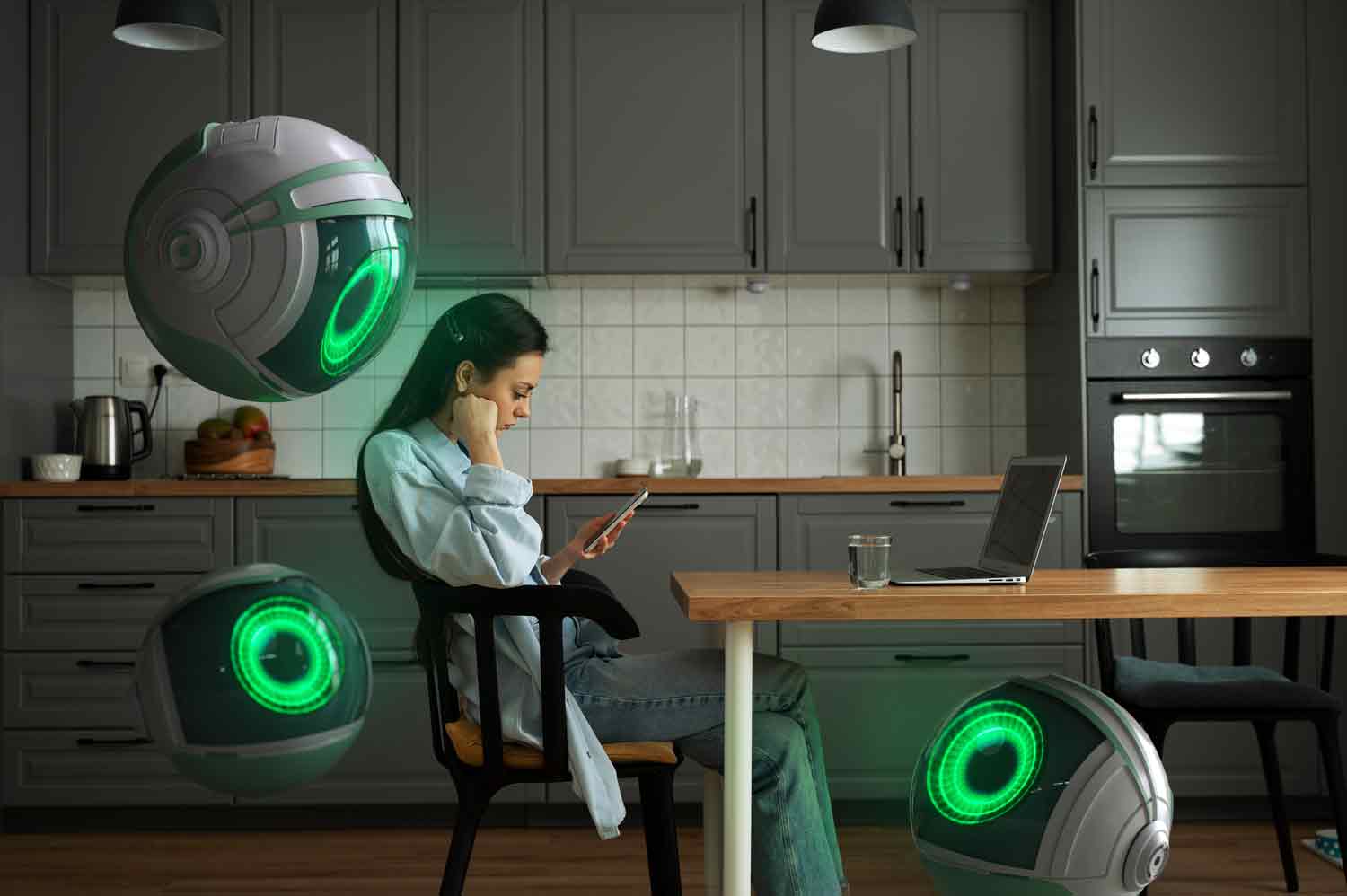Now more than ever, different types of chatbot technologies are playing an increasingly important role in our lives, from the way we receive customer service or decide to purchase a product to the way we carry out our routine tasks carry out. Many of us have come into contact with chatbots or virtual assistants on our phones or through home devices such as Apple’s Siri, Amazon Alexa and Google Assistant. You may have interacted with these chatbots through text messages, social media, or the Messenger
app at work.
Chatbots have made our lives easier by providing quick answers to our questions without having to wait to speak to a human. In this blog, wediscuss different types of chatbots with different levels of technological maturity and which one is best for your business.Before we answer these questions, let’s start with the basics.
Chatbots explained
Chatbot is a conversational tool that aims to understand and automatically respond to customer questions by simulating written or oral human conversations. As you’ll learn below, some chatbots are simple and have simple menu options that users can click on. However, more advanced chatbots can leverage artificial intelligence (AI) and natural language processing (NLP) to understand user input and easily navigate complex human conversations.
What different types of chatbots are there?
1. Chatbot menus or buttons Menu or button-based
chatbots are the simplest type of chatbot that users can interact with by clicking a button option in a scripted menu that best suits their needs. Depending on what the user clicks, a simple chatbot can present the user with a number of other options to choose from until they reach the specific option that suits them best. Basically, these chatbots work like a decision tree.
While these chatbots offer simple functionality and can be useful for answering simple, repetitive user questions, they can be problematic for more specific queries because they are limited to predefined answer options.First, this type of chatbot can take longer to understand customer needs, especially if the user has to go through multiple iterations of menu buttons before settling on the final option. Secondly, if the user’s needs are not covered by the menu option, the chatbot is useless as it does notprovide a free text input field.
2. Rules-based chatbots
Building on the simple decision tree functionality of a menu-based chatbot, a rule-based chatbot uses conditional if/then logic to develop conversation automation flows. Rules-based bots essentially work like interactive FAQs, where the conversation designer programs predefined combinations of question and answer options so that the chatbot can understand the user’s input and respond accurately.
These types of chatbots, based on simple keyword recognition, are relatively easy to train and work well when asked predefined questions. However, like rigid menu-based chatbots, these chatbots cannot handle complex queries.These chatbots struggle to answer questions that the conversation designer did not intend because their results depend on content pre-written and programmed by the chatbot’s creators.
Since the conversation designer cannot predict and pre-program the chatbot for all types of user requests, limited rule-based chatbots often get stuck because they cannot understand the user request. If a chatbot cannot understand a user’s request, it will leave out important details and ask the user to repeat information that has already been shared. This causes frustration for the user and often results in the chatbot redirecting the user to a live support agent. In some cases, switching to the human agent is not possible, resulting in the chatbot acting as a gatekeeper and further frustrating the user.
3. Chatbots with artificial intelligence
While a rules-based chatbot’s conversation flow only supports predefined questions and answer options, AI chatbots can understand a user’s questions regardless of how they are worded. Using artificial intelligence and natural language understanding (NLU) capabilities, an AI bot can quickly recognize all relevant contextual information shared by a user, enabling a more fluid and conversational conversation. If the AI chatbot is not sure what a person is asking and finds more than one
action that can satisfy the request, it can ask clarifying questions. Inaddition, a list of possible actions can be displayed from which the user can choose the option that best suits their needs.
The machine learning algorithms behind AI-powered chatbots enable them to learn autonomously and develop an increasingly intelligent knowledge base of questions and answers based on user interactions. With deep learning, the longer an AI chatbot works, the better it can understand what the user wants to achieve and provide more detailed and accurate answersthan a chatbot with newly integrated algorithm-based knowledge.
ADS
Conversational AI chatbots can remember conversations with users and incorporate that context into their interactions. Combined with automation features like Robotic Process Automation (RPA), users can complete tasks through a chatbot. For example, if you order a pizza, a restaurant’s chatbot could recognize a repeat customer to place an order, greet them by name, remember their “normal” order, and use their registered delivery address and credit card to complete the order.Through deep integration with business systems, an AI chatbot can pull information from multiple sources, including the customer’s order history, and optimize the ordering process.
Additionally, if a user is unhappy and needs to speak to a human agent, the transfer can be seamless. Once broadcast, the live support agent can access the chatbot’s conversation history and knowingly initiate a conversation.
The time it takes to build an AI chatbot can vary depending on factors such as the technology stack and development tools used. complexity of the chatbot; desirable characteristics; data availability; and when you need it to integrate with other systems, databases or platforms. You can build AI chatbots faster with an intuitive no-code or low-code platform.
With Watsonx Assistant, chatbots can be trained on small amounts of data to properly understand the user and can be enhanced with search capabilities to search existing content and provide answers that cover questions beyond what was originally suggested by the conversation Designer chatbot was programmed by the user.
IBM Watsonx Assistant accelerates virtual agent deployment by:
Improved intent recognition using advanced language models (LLM) and advanced NLP and NLU
Voice chatbots
Voice Chatbot is another chat tool that allows users to interact with the bot by speaking to it instead of typing. Some voice chatbots may be simpler. Some users may be frustrated with Interactive Voice Response (IVR) technology, particularly when the system fails to obtain the information the user is looking for from the programmed menu options and puts the user on hold. However, this system is evolving with artificial intelligence.
AI-powered voice chatbots can offer the same advanced features as AI chatbots, but are deployed in voice channels and leverage text-to-speech and text-to-speech technologies.Through NLP and the integration of IT and telephony technologies, voice chatbots can now understand spoken questions, analyze users’ business needs and provide appropriate answers in a conversational tone. These elements can increase customer loyalty and agent satisfaction, improve call resolution rates, and reduce wait times.
While chatbots and voice bots aim to identify user needs and provide helpful answers, voice chatbots can provide a faster and more convenient method of communication as it is easier to get a response in real time without tapping or clicking on options when shutting down to have to.
5. Chatbot with generative artificial intelligence
The next generation of chatbots with generative AI capabilities can provide even greater functionality by being able to understand common language, adapt to a user’s conversational style, and use empathy when answering user questions. While conversational AI chatbots can analyze user questions or comments and generate human-like responses, generative AI chatbots can go even further by generating new content as output. This new
content may appear in the form of high quality text, images and audiodepending on the LLM they are training for. Chatbot interfaces with generative AI can recognize, summarize, translate, predict, and create content in response to a user’s query without the need for human interaction.
ADS
Which chatbot type is right for your company?
When evaluating different types of chatbots and determining which onesare best for your business, remember to put the end user at the center of the decision. What goals and expectations do your users have for your company and what preferences do they have for the user experience of a chatbot? Would you rather choose from a simple menu of buttons or do you need the ability to answer detailed questions in an open dialogue?
Also consider the state of your business and the use cases of your chatbot, whether it is a lead generation chatbot, an e-commerce chatbot, or a customer or employee support chatbot.If you work for a small business, such as a startup, with a limited number of active users and a minimumnumber of FAQs that chatbot conversation designers should pre-program, a rule-based chatbot or rule-based keyword recognition could be enough to solve your problems. Meet business needs and satisfy customers without requiring major growth.
However, for medium to large businesses that store large amounts of user data from which a chatbot can learn on its own, an AI-powered chatbot can be a beneficial solution to provide users with detailed, accurate answers and a better customer experience.
As you consider the impact of generative AI on chatbots, consider how your business can benefit from creative conversational responses and when this technology is best suited to your business goals and customer needs.




